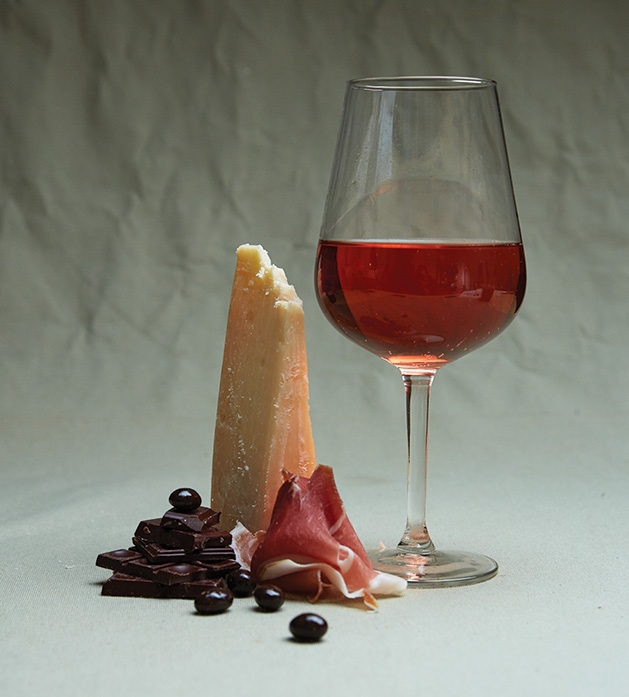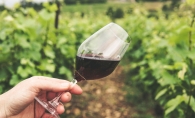
You just never know until you try it. That’s certainly the case here, at least, because the combination of cheese and chocolate isn’t the first food pairing that comes to mind. Both foods pair well (separately) with wine; chocolate is wonderful with tea, and cheese and beer are a match made in heaven. But the ménage à trois —chocolate, cheese and wine—makes for a sensory-taste experience like no other.
Lunds & Byerlys FoodE expert Joan Donatelle and France 44’s wine specialist Karina Roe give us the lowdown on cheese, chocolate and wine pairings, plus key tips to enjoy the combinations.
Chocolate + Wine
Chocolate and wine are a tried-and-true combination, especially when Valentine’s Day is just around the corner. But as it turns out, we may have been combining the wrong chocolate with the wrong wine. Roe says that though dark chocolate and a deep, red wine seems like the best pairing, it is not. “Chocolate has tannin [an acidic ingredient] in it, just like red wine does. So it’ll dry out your mouth and taste astringent,” she says.
But that doesn’t mean that pairing red wine with dark chocolate is barred. Roe recommends a pinot noir or a grenache—two red wines that are lower in tannin. “Make sure [the wine] is more fruity, ripe and juicy, and not super tart,” she says.
On the other hand, consider plating milk chocolate with a dessert wine, such as port. With a smaller percentage of cacao, milk chocolate is sweeter and easier to pair with a rich red wine. Roe says if you match the sugar content of the chocolate to that of the wine, the pairing will balance out.
As for a white or rosé wine? Roe recommends sticking to red. “Only in extreme instances can the two go together …. They just don’t have the level of sweetness or intensity of flavor to make for a good chocolate pairing,” she says. However, a sparkling Champagne or sparkling rosé goes well with a lighter chocolate, such as milk or white chocolate. Roe recommends Voirin-Jumel. “It has a lot of great depth of flavor, and almost tastes like a chocolate nougat by itself,” she says.
Cheese + Wine
When pairing cheese with wine, both Roe and Donatelle opt for three categories: Alpine, blue and cheddar cheeses. Then pair each type of cheese to a specific wine. It’s important to note that both experts recommend pairing one cheese to one wine, since it’s challenging to pair multiple cheeses to one wine.
Pairing Alpine cheeses is much like pairing dark chocolate—pair a northern cheese, such as Gruyere or chevre cheese, with a medium-bodied, northern wine. “I love to stick to where the cheese comes from,” Roe explains. “That’s where the wine should come from too. Look to a northern climate, like northern Italy, for slightly delicate wines to go with Alpine cheeses.”
As for blue cheese, Donatelle recommends Cashel blue, Gorgonzola or a brie. To pair, go for a full-bodied red, such as a syrah or cabernet.
“[Blue cheeses] can be tough to handle on their own, but drizzle it with a little bit of honey … or smear it on bread,” Roe says.
Cheddar and farmstead cheeses happen to be one of the easiest to pair to wine, but might bring the most surprising combinations. Roe says, “I love a fudgy, buttery cheddar cheese with chardonnay. It’s a little surprising, because you’re matching the flavor and texture [of the cheese] to that of the wine.” Widmer’s 4 Year aged cheddar or Westminster Farmhouse English cheddar cheese are two that pair well.
Chocolate, Cheese + Wine
You know what they say—opposites attract. And that’s the case for this trio. Puianello Lambrusco, a sparkling red wine, should be your go-to when combining the trio. “Serve it chilled, and it goes excellent with Parmigiano-Reggiano,” Roe says. “Put that on a plate with your choice of chocolate and prosciutto … that’s an excellent cheese tray.”
To spice up your Valentine’s, Donatelle suggests grabbing a box of assorted truffles, triple-crème cheeses and a Champagne for a romantic plating. Opt for a rosé prosecco (or a white prosecco if rosé isn’t your jam) to add an extra layer of fruity flavors that pair well with cheese and light chocolate.
To bring the three together, start by tasting each on its own, beginning with the chocolate, to explore the aroma and flavor. Then place a piece of chocolate in your mouth, to allow it to melt, about 10 seconds. Take a small sip of wine, then take a bite of the cheese. Enjoy the aromatic flavors!
Tasting Tips + Tricks
Donatelle is no stranger to tastings. She shares with us some of her best tips.
First, consider your budget and number of guests. Then move into buying the chocolate, cheese and wine, setting up placemats and creating your board. For plating, go one of two ways: individual paper placements at a table tasting or a rectangular plate for each person with a large board.
“A large cheese board creates more of a grazing style,” Donatelle says. It’s easier to spread out the different kinds of cheeses and chocolates, plus additional appetizers. Garnish with rosemary sprigs and kumquats, on top of adding almonds, fig jam and honey.
One of her most important tips is to set out a palate cleanser. “[Be sure to] add a plain water cracker to help cleanse your palate in between samples,” she says. That way you can be sure to keep the dark chocolates from the milk, the cheeses from the cheddars and the deep reds from the Champagne.
France 44
4351 France Ave. S., Minneapolis
Facebook: France 44 Wine & Spirits
Lunds & Byerlys
3455 Vicksburg Lane N., Plymouth
Facebook: Lunds & Byerlys









